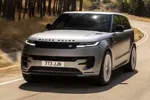As Automotive Managemnent (AM) asks UK car retail businessses to share their hopes and fears for a COVID-19 and Brexit-impacted year ahead in the 'Outlook 2021 Survey', David Borland, EY UK & Ireland automotive leader suggests there could be cause for "cautious optimism".
Read on as he reflects of the past year and the impacts of current market pressures on the 12 months ahead.
To use a driving metaphor to describe 2020, one could say that we started the journey expecting fair conditions, but after a few miles hit freezing fog, navigated an extreme blizzard, faced two road closures, then to top it all got stuck at passport control in a seemingly never ending debate.
It’s fair to say this year has been a journey like no other.
Perfect storm of market destabilisers
As I have already commented on, we are experiencing the perfect storm of challenges affecting the automotive industry: with the pandemic, Brexit and supply issues all impacting consumer confidence and demand for new vehicles.
It has been well documented how impactful the pandemic has been. With the country having faced two lockdowns, working from home being mandatory for most, and consumer confidence battered and bruised – it comes as no surprise that sales are down 31% YTD.
The sliver of good news being the continued resilience of the industry, a movement towards green vehicles with BEVs seeing a 162% increase, PHEVs up 89% and LCVs seeing an 8.8% increase on last year, down to latent fleet deals.
Brexit – going down to the wire
With Brexit negotiations (at time of writing) still ongoing, the sector faces the scenario of trading within WTO rules if no deal is agreed.
This could result in customs and border delays leading to supply issues, and possible price increases for consumers as a result of tariffs and the need for stockpiling.
Let’s not forget how significant this is – 90% of passenger cars sold in the UK are imported, with 70% coming from the EU, and 80% of cars produced here are exported, with more than 50% heading across the channel to the EU.
Over 80% of parts are imported from the EU worth more than £10bn, and even though the potential tariff increases are lower, it will still have a very material affect and the costs will need to be absorbed somewhere.
The Society of Motor Manufacturers and Traders (SMMT) has estimated that a no deal could cost the sector £55bn, with ACEA estimating an overall impact to the European sector of EUR110bn.
But that said, even if a EU-UK deal is secured then significant change is still inevitable, particularly for those businesses who rely on cross-border supply chains.
So regardless of the outcome of the negotiations, supply issues for dealers and their customers could well be an issue from January, at least in the short-term.
Effects of COVID-19 – continuing well into 2021
Even though the UK has just started the roll-out of its vaccination, the affects of COVID-19 are still likely to be felt well into next year, with the fear from some quarters that the country may go into a third lockdown following the limited relaxation of restrictions over the Christmas period.
Added to that, the forecasts suggest only 50% of the population can be immunised in 2021, meaning it is unlikely we will return to the ‘old normal’ anytime soon, if ever.
But manufacturers, suppliers and dealers have shown resilience and innovation during these testing times, as demonstrated by improved trading during lockdown 2.0 through their experiences and learnings from the lockdown 1.0.
Bright side of the moon
After what can only be described as ‘annus horribilis’, it’s easy to overlook the opportunities that still exist.
We expect demand for electric vehicles (EVs) to continue to rise in 2021, buoyed by the support being offered in the Government’s 10 Point Plan to enable the transition, and attractive tax rates versus ICE vehicles.
As transport contributes over 20% of EU CO2 emissions, we see significant demand for green vehicles in fleet, where they will play a critical role in helping companies achieve net zero targets, whilst lowering TCO.
While new car sales may well face a challenging environment in the months to come, the picture for used car sales appears brighter.
A combination of: the risk of Brexit creating new vehicle supply constraints, further compounded by COVID-19 outbreaks affecting manufacturers and suppliers production; commuter habits changing as motorists are travelling less and those that opt to not travel on public transport seek alternative modes the perceived value for money that used vehicles offer; and increased levels of disposable income for some as their opportunities to spend have been limited during lockdown – could all lead to a continuing demand for quality used vehicles.
As the car parc ages due to less new cars on the road, there will be opportunities in the profit engines of service lanes.
2021 and beyond
It’s been a tough year for all, and the unfortunate reality is that there is potential for more job losses in 2021, as support mechanisms come to an end.
But with a national vaccine program under way it is hoped that consumer confidence and travel will start to return to some degree, followed, hopefully, by more stable demand for new vehicles over the course of 2021.
We believe that companies will collaborate across sector boundaries more than ever before, unlocking new value pools as we transition to alternative fuel vehicles.
It will be by no means be an event free journey, but we can enter the new year with a certain level of cautious optimism for the year ahead, pulling on the British spirit and resilience that will be needed as we continue in the most unprecedented times.














Login to comment
Comments
No comments have been made yet.